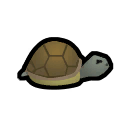Tortoise
Tortoise
"This heavily armored land-dwelling reptile is known for its slow moving speed and surprisingly vicious bite. Because of its natural armor, it is tough to kill and can do serious damage during drawn-out melee fights."
Base Stats
Apparel
- Armor - Sharp
- 50%
- Armor - Blunt
- 35%
Pawn Stats
- Move Speed
- 1.0 c/s
- Health Scale
- 0.6
- Body Size
- 0.5
- Mass - Baby
- 6 kg
- Mass - Juvenile
- 15 kg
- Mass - Adult
- 30 kg
- Carrying Capacity
- 38 kg
- Filth Rate
- 1
- Hunger Rate
- 0.53 Nutrition/Day
- Diet
- omnivorous
- Life Expectancy
- 180 years
- Manhunter Chance
- 2%
- Manhunter Chance (Taming)
- 1.25%
- Trainable Intelligence
- Intermediate
- Wildness
- 75%
- Minimum Handling Skill
- 7
- Maturity Age
- 0.5 years (30 days)
- Comfortable Temp Range
- -0 °C – 50 °C (32 °F – 122 °F)
Production
- Meat Yield
- 70 tortoise meat
- Leather Yield
- 21 lizardskin
- Eggs Per Clutch
- 2 to 3
- Egg Laying Interval
- 20 days
- Can Lay Unfertilized Eggs
- false
- Gestation Period
- 10 days
- Offspring Per Birth
- 1-3
Melee Combat
- Attack
- Beak
9 dmg (Bite)
13 % AP
186 second cooldown - Average DPS
- 0.03
Tortoises are crawling omnivores which live in the moderate climates of the temperate forest and the sweltering humidity of the tropical rainforest. Its thick shell gives it 35% blunt damage resistance and 50% sharp damage resistance. Their small body size, built-in armor, and moderate health means that a hunter will need several shots to take one down.
They can often be seen engaging predators in fighting, and unlike other prey animals, they can emerge victorious.
Analyis
| This section is a stub. You can help RimWorld Wiki by expanding it. Reason: Please add a reason . |
Armor
| Armor |
|---|
Taming
Tortoises are fairly easy to tame. Tortoise ranching can be a rewarding experience as maintenance costs are low and fresh females can be constantly recruited in the right biomes. Though they will not explode into a dwarf fortress "2cat" style of overpopulation in the same way a few chickens can manage to, players can still build up large tortoise farms and use them as a steady source of income. Alternatively they can be raised for doctors to train medical skills by euthanizing or for training the melee skill. Because of the creature's armor and low damage output, a well-armored colonist can land many blows without much risk, quickly raising the melee skill substantially. One strategy is to allow warriors needing training in melee to fight, (but not kill) the animal, then for doctors to mend the creature's wounds, allowing them to train their skill, too. Rinse and repeat a few times until the poor beast has been tenderized enough to be given to the cooks for a nutritious final disposition.
Some care must be used when managing tortoise eggs, as tortoises themselves are omnivorous and do not seem to discriminate against eating their unhatched young. Make use of restriction zones and hauling labor to pull freshly laid eggs away from animal pens and into safe hatcheries to maximize yield.
Their heavy armor and small size makes them a decent combat animal despite their low damage output, easily occupying attackers' time, and they may even survive to down a raider. Their extremely slow speed makes them impractical to use in offensive raids. However, prepositioning tortoises by restricting their area to chokepoints can sometimes be quite helpful when defending.
Training
This animal can be trained as follows:
| Guard: | |
|---|---|
| Attack: | |
| Rescue: | |
| Haul: | |
*As of version 1.1.2610, all animals can be tamed. The percentage of likelihood of success depends on factors such as the Animals Wildness Percentage, Pawn Handling Skill, and others. More information can be found on the animals page.
Health
Version History
In version 1.0 Tortoise armor was reduced from 50% to 30%. At some point it was increased back up to its current value.
